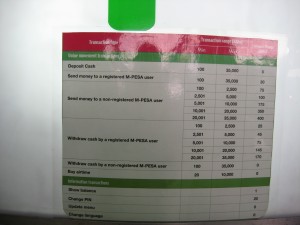Levis said with visible relief after we’d marked the location of Big Five Tours on Khapta road, explaining to yet another set of curious security guards what we were up to. Clearly, he’d been genuinely afraid after the morning’s workshop. Having run out of batteries almost immediately out of the gate, in both my GPS and my digital camera, I can’t say I fared too well in the trial-run mapping party. But we managed to get a group of Danish students working on climate change advocacy really excited about mapping, and most of them returned with long tracks and careful notation. So far, so good.
It’s been a whirlwind week here in Nairobi. As I write, Mikel is making an impromptu presentation of the project for members of Pamoja Trust, one of the most well-known and respected community organizations working in Kibera. And yesterday we spent the whole day at MS ActionAid Kenya, where the Danish students were introduced to mapping techniques along with several others from organizations as diverse as Ushahidi, UNICEF, Umande Trust, and World Bike. We actually walked around with the GPS units in the Westlands neighborhood. This was also great practice for those of us who will be working on the project but aren’t exactly fully versed in the technical aspects of mapping, shall we say.
There have been so many helpful yet challenging conversations with groups on the ground here in Nairobi that my head is now spinning. Kipp and Phillip from a group called Sodnet have offered us advice and also precious office space, just out of a sense of cameraderie and shared goals. On Tuesday, we went down to Kibera and trekked around in the mud before we found Carolina for Kibera’s office, where we talked to Kenny about practical details and some practical realities. Out of this conversation, we now have a game plan for recruiting local youth as well as an all-important meeting with the village chiefs next week for their blessing. Around every corner, it seems, is another person offering support and advice, and every time there are unexpected connections that vouch for the shrinking globe.
One emerging theme in our discussions with various community organizations and international development folks is that the collection of map data can be perceived in many different ways. We certainly won’t be the first to collect information from the citizens in this highly targeted neighborhood, and even if the data doesn’t require talking to anyone (we’re recording visible features, not demographics), the very process will mean talking to everyone. What is the information being collected for, and what will it bring with it? Usually, such surveying is done in anticipation of a government relocation, or slum upgrading program, or a new water scheme, or a sewage project, or, currently, a plan to move people who live too close to the railroad line. It may be difficult to impart what seems obvious to those who conceived of a project like OpenStreetMap – that it’s by and for the people, it’s unowned, another way to move control of information into the public domain and into public hands. In this vein, we’re involving community groups who work on media and technology here since they have already worked on some of the same goals. Community media – TV, radio, film – has made major inroads through some truly amazing projects like Carolina for Kibera’s work with Flip cameras, local newspaper Kibera Journal, and Pamoja FM’s radio outreach. It’s exciting to see that when it comes to journalism, storytelling and reporting is already in the hands of citizens themselves. If all goes well, we’ll be able to produce some interesting media together. Stay tuned.
 I learned that you could send money to almost anyone, including the cop pressing you for a bribe. We were even told muggers might demand your
I learned that you could send money to almost anyone, including the cop pressing you for a bribe. We were even told muggers might demand your